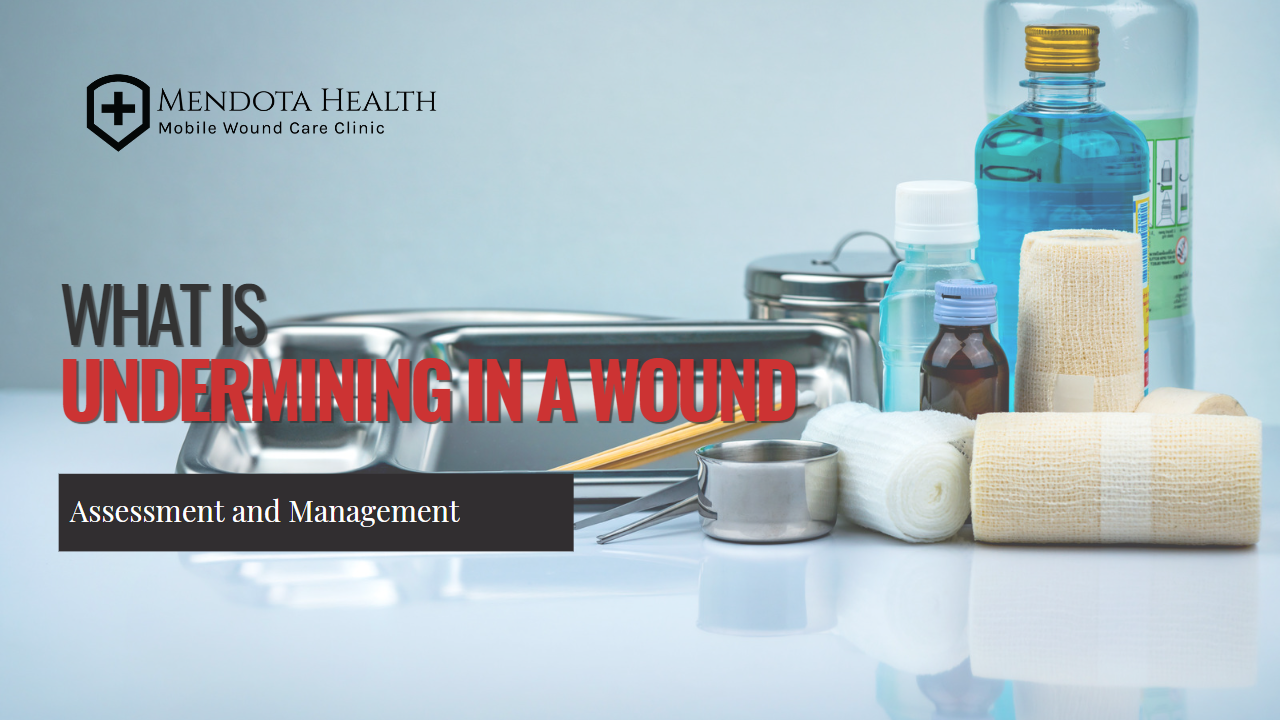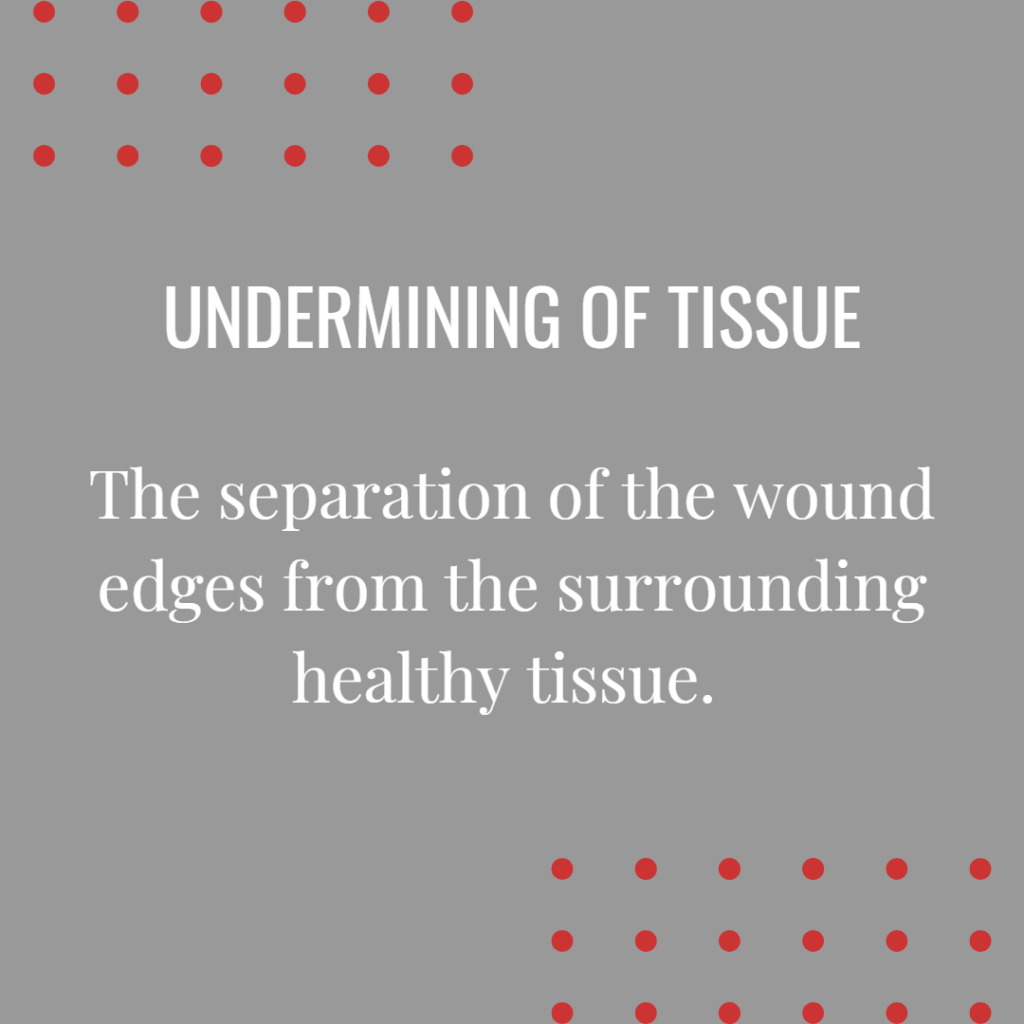
16 Feb What Is Undermining In A Wound?
Wounds that are not healing properly can often lead to secondary complications such as infections and tissue damage. One type of complication that can be particularly problematic is undermining of the wound. In this blog post, we will discuss what undermining wounds are, how they are different from tunneling wounds, and how to assess and manage these types of wounds.
What is the difference between tunneling and undermining?
Tunneling and undermining are both terms used to describe wounds that are not healing properly, but they refer to different types of wound complications. Tunneling occurs when a wound extends deeper into the tissue than its surface, creating a channel or tunnel. On the other hand, undermining refers to a separation of the wound edges from the surrounding healthy tissue, often creating a “pocket” under the wound surface.
What causes wound undermining?
Wound undermining can be caused by a variety of factors, including pressure, shear, moisture, and infection. The presence of any of these factors can cause the wound to enlarge and prevent proper healing, leading to undermining of the tissue.
What is undermining of tissue?
Undermining of tissue refers to the separation of the wound edges from the surrounding healthy tissue.

how do you assess and undermining wound?
The assessment of an undermining wound involves evaluating the extent of the undermining, the surrounding tissue, and the underlying structures. To assess an undermining wound, the clinician should inspect the wound for depth of separation, look for evidence of any tunnels or pockets, and check for any signs of infection or inflammation.
What is undermining for wound closure?
Undermining can have a significant impact on wound closure and healing, as the separation of the wound edges from the surrounding tissue can prevent the wound from closing properly. To close an undermining wound, the clinician may need to remove any damaged or infected tissue, clean wound and control infection, and promote granulation tissue formation.
What does undermining mean in pressure uclers?
Undermining in pressure ulcers can occur due to the pressure and friction that is placed on the skin and underlying tissue, leading to tissue damage and the formation of a “pocket” under the wound surface.
What are 3 methods of wound closure?
The methods of wound closure are primary intention, delayed primary, and secondary intention.
- Primary intention: This type of wound closure is used when the edges of the wound can be brought together and closed with sutures, staples, or adhesive strips. The wound is then typically covered with a sterile dressing. Primary intention closure is used for wounds that are clean, have straight edges, and are not very deep. This type of closure results in minimal scarring and a quicker healing time.
- Delayed primary intention: This type of wound closure is used for wounds that are not suitable for primary intention closure but are not severe enough to require secondary intention closure. Delayed primary intention involves cleaning the wound and leaving it open for a few days to allow any swelling or infection to subside. After a few days, the wound is then closed with sutures or other closure techniques, similar to primary intention closure.
- Secondary intention: This type of wound closure is used for wounds that are too deep or too infected to be closed with primary or delayed primary intention. Instead, the wound is left open to heal from the inside out. This type of closure can take longer to heal, and it may result in a larger scar or more visible scarring. Secondary intention closure is often used for wounds that are caused by trauma, chronic conditions, or infections.
It’s important to note that the type of closure used will depend on the location, depth, and severity of the wound. In some cases, a combination of closure methods may be used to ensure the best possible outcome. Healthcare professionals will assess the wound and recommend the most appropriate closure method based on the individual needs of the patient.
Do you pack undermining wounds?
Undermining wounds may be packed with sterile gauze or other wound dressing materials in order to help promote healing and reduce the risk of infection. Packing the wound helps to fill the gap between the skin and underlying tissues, creating pressure that promotes tissue regeneration. The type of dressing and frequency of changing will depend on the specific needs of the wound, and healthcare professionals should monitor the wound regularly to ensure that the dressing is not causing further irritation or infection.
Conclusion
Undermining wounds can be a complex and challenging issue for both patients and healthcare professionals. Understanding the differences between tunneling and undermining, as well as the best ways to assess and treat these wounds, is crucial for promoting effective healing and reducing the risk of complications. If you are concerned about an undermining wound, it is important to seek medical attention as soon as possible to receive an accurate diagnosis and appropriate treatment plan.

